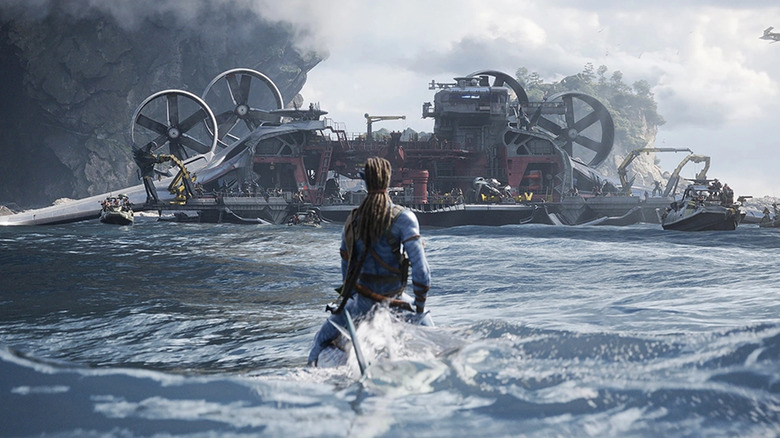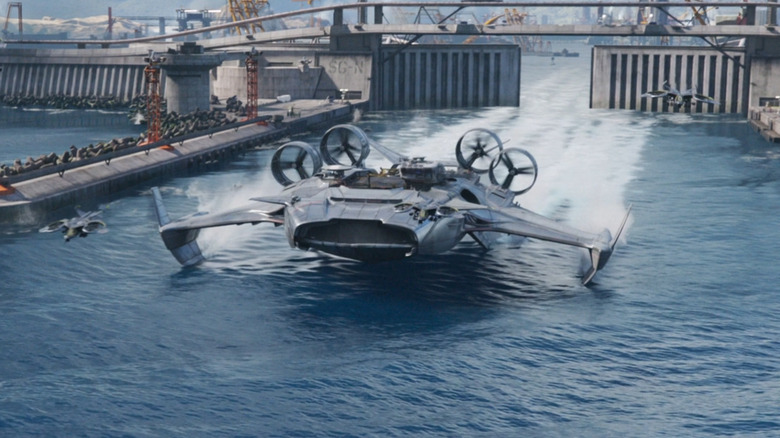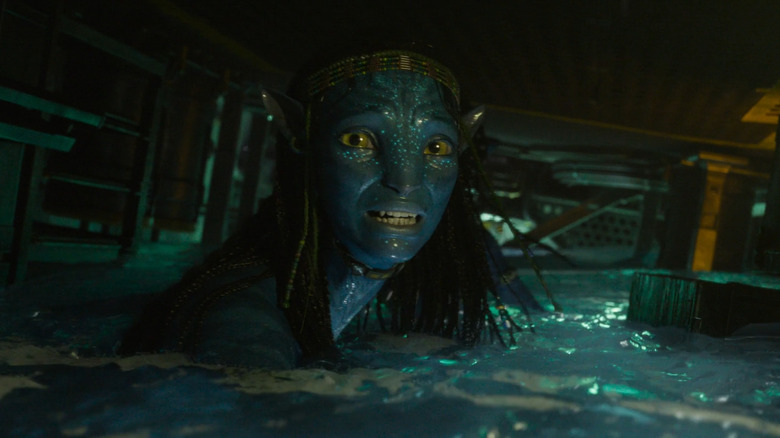A Manta Ray Helped Avatar: The Way Of Water's Crew Crack The SeaDragon Ship Design
While "Avatar: The Way of Water" is staying well afloat at the box office thus far, the sky people do so a bit differently on Pandora. The sequel explores a new side to the alien planet that really puts the "water" in the film's title. The Na'vi are able to traverse the watery area thanks to their trusty aquatic friends, but the humans are not as subtle. The invading forces bring in new and improved gear this time around to fit the wet environment. The film fittingly introduces the SeaDragon, a giant ship that serves as the base of operations for the whale poachers and Quaritch (Stephen Lang) and his military lackeys.
Although the Na'vi people are still front and center in "The Way of Water," greedy humans linger in the foreground as a land-ravaging threat to the planet. The RDA is back stronger than ever, seeking war with the Na'Vi in its search for another, more aquatic natural resource. The SeaDragon ship is the vessel for that cause, a man-made disastermobile made to hunt down tulkun for their brain fluids and coincidentally battle the Na'Vi from time to time. James Cameron is no stranger to big ships, nor the ocean, but the filmmaker went for an animal-based look for "The Way of Water."
'Designed to consume things'
In an excerpt from "The Art of Avatar The Way of Water" book, production designer Ben Procter revealed they used the silhouette of a sting ray as the basis for the SeaDragon ship design. After much deliberation between Cameron and the designers, the final look included the horns of a manta ray to give it a wide-spanning presence. However, the ship was also meant to resemble another animal, often characterized by its method of consumption:
"It's a ship that is designed to consume things. And the front end of it looks kind of like a whale shark's mouth, so the metaphor carries through in that the vehicle opens its whole face. In a spooky, bizarre way, the vehicle opens its entire head into kind of a feeding orifice, so to speak."
Although manta rays are actually known for being quite friendly, their speed and body type are traits that could best describe the SeaDragon. The ship is fast enough to keep up with the tulkun, and its wingspan helps create the staggering silhouette that makes the size of everything around it pale in comparison. Combine that with the imposing mouth of a whale shark, and you have a pretty scary vehicle. The final battle takes on and around the SeaDragon, which meant the mechanical animal also had to serve as one giant set for all facets of production, live-action and 3D animated.
A new kind of Death Star
Unlike the first film of the franchise, "Avatar: The Way of Water" aptly took things off-land to settle the big dispute between the Na'Vi and the humans, who look to kill Jake Sully (Sam Worthington). The third act almost entirely revolves around the landscape of the SeaDragon, before and after it sinks. To Proctor, the SeaDragon is the Death Star of "The Way of Water," which meant it had to be designed in detail from top to bottom in a way that moved the story forward:
"The SeaDragon is one gigantic set in an overall sense. It required a layout in 3D that incorporated all the different elements, live-action exterior sets, live-action interior sets, and virtual sets that must web together. There are boats being launched, aircraft taking off, dramatic character scenes, and action scenes with characters climbing, hiding, sneaking around, and fighting."
So yeah, the climactic set pieces were always meant to happen on a big ol' manta ray-looking boat. No one does action as Cameron does, and the director shows no sign of wear or tear in that department with "The Way of Water." But making the SeaDragon a backdrop for the major story beats also favors the film's central message. The artificial beast that hunted down aquatic wildlife for profit is killed in dramatic fashion, sinking as everything else rises above it.
Death Star or not, the SeaDragon served as a great means to conclude the worthy sequel. Of course, you have to see it to believe it. "Avatar: The Way of Water" is currently in theaters, if you haven't noticed.


